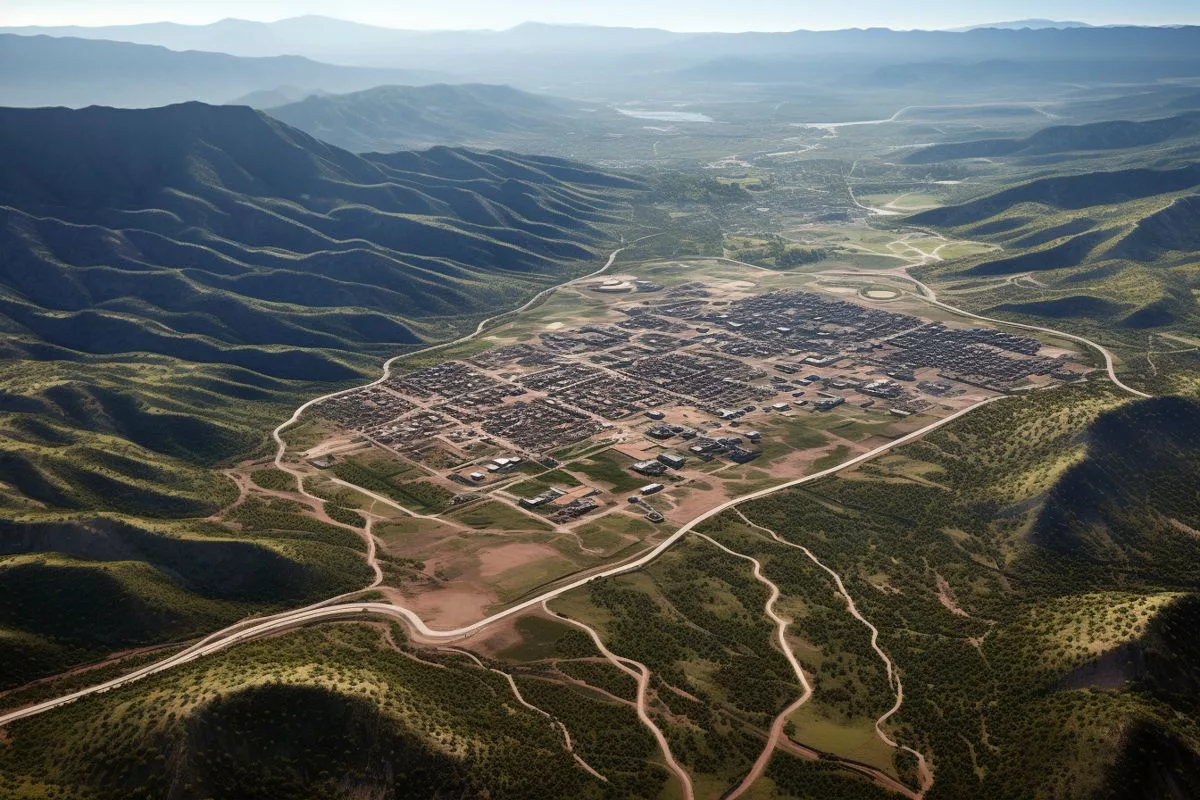The Philippi Opportunity Area LSDF is a plan endorsed by the local council to guide local planning and investment in public infrastructure. The plan envisions a transformed POA that includes mixed-use and transit-oriented development, safe neighborhoods, and community involvement. The LSDF promotes economic development, emerging economic activities, aesthetics, and community participation. With the plan approved, the POA is ready to be a catalyst for development and change in the metro-south east, promising sustainable development and community engagement.
What is the Philippi Opportunity Area LSDF?
The Philippi Opportunity Area (POA) Local Spatial Development Framework (LSDF) is a plan endorsed by the local council to guide meticulous local planning and investment in public infrastructure. The LSDF recognizes the potential of the POA to act as a launchpad for development in the metro-south-east and envisions a metamorphosed POA that encapsulates the ethos of mixed-use and transit-oriented development (TOD). The LSDF aims to foster safe, easily navigable neighborhoods for inhabitants, workers, and visitors while empowering emerging economic activities and fostering community involvement.
Genesis of the Spatial Vision
In an exhilarating development for Cape Town, the local council recently endorsed the local spatial development framework (LSDF) for the Philippi Opportunity Area (POA). The LSDF acts as a torchbearer, illuminating the route to meticulous local planning and investment in public infrastructure. This sets the stage for prospective development opportunities.
The POA, nestled in the metro-south-east and fringing the Philippi Horticultural Area, holds a strategic geographical advantage. Its proximity to the vibrant Cape Town International Airport and the principal access routes of the N2 and the R300 significantly contributes to its transformation into a robust, sustainable, and resilient locality. The LSDF recognizes the potential of the POA, which includes areas like Philippi East, the Philippi Industrial Area, Heinz Park, Nyanga, Crossroads and a small part of Gugulethu, to act as a launchpad for development in the metro-south-east.
Thriving Urban Spaces
The LSDF envisions a metamorphosed POA that encapsulates the ethos of mixed-use and transit-oriented development (TOD). The emphasis lies on creating urban areas that seamlessly integrate higher density residential growth with retail and recreational spaces. These zones, according to the LSDF, would lie within walkable districts reinforced by transportation amenities and high-quality social facilities.
As Alderman Eddie Andrews, the city’s Deputy Mayor and Mayoral Committee Member for Spatial Planning and Environment underscores, the LSDF also promotes economic development. This can be achieved through enhancing road connectivity with the PHA, the airport, and existing industrial operations. Alongside this, the LSDF aims to revamp spaces and facilities to streamline the informal economy and provide it with a growth-oriented platform. The ultimate vision is to foster safe, easily navigable neighborhoods for inhabitants, workers, and visitors.
Empowering Economic Activities
To harness the area’s potential fully, the LSDF proffers a series of measures. These include improving accessibility through reengineered and upgraded local roads, utilizing vacant or underused state-owned land to address local needs, and constructing a variety of mixed-use affordable housing models catering to diverse income groups and lifestyles.
In addition, the LSDF seeks to foster emerging economic activities such as agri-processing, expansion of the Fresh Produce Market, food production, and waste recycling and processing. Informal trading will also find support through strategically positioned markets and trading spaces.
Aesthetics and Community Involvement
The LSDF’s vision extends beyond practicality, encompassing aesthetics, and community participation. It promotes the creation of safe, pedestrian-friendly public spaces and appreciates the area’s distinct character and heritage, including historic tree avenues. Within this structure, the LSDF suggests the formation of a green network incorporating parks, multi-functional stormwater and sports facilities, and food garden spaces.
The formulation of the LSDF has been an inclusive endeavor with substantial public participation. Stakeholders and the local community have provided crucial insights and proposals for the draft LSDF through series of workshops and engagements. As Alderman Andrews points out, these contributions were pivotal in shaping this dynamic process.
Forging Ahead
With the LSDF now approved, the essential interventions, projects, and investments proposed within it will form the driving force to materialize the spatial vision. In Alderman Andrews’s words, the newly ratified LSDF will serve as a roadmap for land use, development, and investment in the POA.
As Cape Town sets out on this transformative journey, the Philippi Opportunity Area stands on the cusp of a new epoch, prepared to accept its role as a catalyst for development and change in the metro-south east. With the new spatial vision, the urban landscape of Cape Town is poised for a vibrant and dynamic transformation, promising a compelling combination of sustainable development and community engagement.
1. What is the Philippi Opportunity Area LSDF?
The Philippi Opportunity Area (POA) Local Spatial Development Framework (LSDF) is a plan endorsed by the local council to guide meticulous local planning and investment in public infrastructure. The LSDF recognizes the potential of the POA to act as a launchpad for development in the metro-south-east and envisions a metamorphosed POA that encapsulates the ethos of mixed-use and transit-oriented development (TOD). The LSDF aims to foster safe, easily navigable neighborhoods for inhabitants, workers, and visitors while empowering emerging economic activities and fostering community involvement.
2. What is the vision of the LSDF for the POA?
The LSDF envisions a metamorphosed POA that encapsulates the ethos of mixed-use and transit-oriented development (TOD). The emphasis lies on creating urban areas that seamlessly integrate higher density residential growth with retail and recreational spaces. These zones would lie within walkable districts reinforced by transportation amenities and high-quality social facilities. The LSDF also seeks to promote economic development, emerging economic activities, aesthetics, and community participation.
3. What measures does the LSDF proffer to empower economic activities?
To harness the area’s potential fully, the LSDF proffers a series of measures. These include improving accessibility through reengineered and upgraded local roads, utilizing vacant or underused state-owned land to address local needs, and constructing a variety of mixed-use affordable housing models catering to diverse income groups and lifestyles. In addition, the LSDF seeks to foster emerging economic activities such as agri-processing, expansion of the Fresh Produce Market, food production, and waste recycling and processing. Informal trading will also find support through strategically positioned markets and trading spaces.
4. What is the role of aesthetics and community involvement in the LSDF?
The LSDF’s vision extends beyond practicality, encompassing aesthetics, and community participation. It promotes the creation of safe, pedestrian-friendly public spaces and appreciates the area’s distinct character and heritage, including historic tree avenues. Within this structure, the LSDF suggests the formation of a green network incorporating parks, multi-functional stormwater and sports facilities, and food garden spaces. The formulation of the LSDF has been an inclusive endeavor with substantial public participation. Stakeholders and the local community have provided crucial insights and proposals for the draft LSDF through series of workshops and engagements.
5. What is the genesis of the spatial vision?
In an exhilarating development for Cape Town, the local council recently endorsed the local spatial development framework (LSDF) for the Philippi Opportunity Area (POA). The LSDF acts as a torchbearer, illuminating the route to meticulous local planning and investment in public infrastructure. This sets the stage for prospective development opportunities. The POA holds a strategic geographical advantage in the metro-south-east and fringing the Philippi Horticultural Area, with proximity to the Cape Town International Airport and principal access routes of the N2 and the R300.
6. What is the next step after the LSDF approval?
With the LSDF now approved, the essential interventions, projects, and investments proposed within it will form the driving force to materialize the spatial vision. The newly ratified LSDF will serve as a roadmap for land use, development, and investment in the POA. The Philippi Opportunity Area stands on the cusp of a new epoch, prepared to accept its role as a catalyst for development and change in the metro-south east. With the new spatial vision, the urban landscape of Cape Town is poised for a vibrant and dynamic transformation, promising a compelling combination of sustainable development and community engagement.












